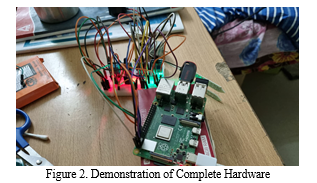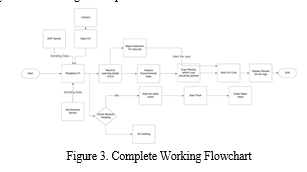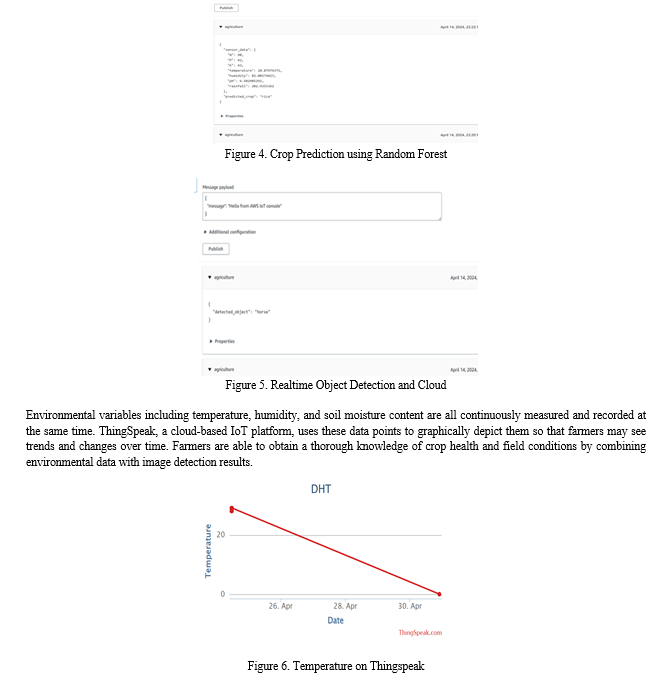Ijraset Journal For Research in Applied Science and Engineering Technology
- Home / Ijraset
- On This Page
- Abstract
- Introduction
- Conclusion
- References
- Copyright
IoT Based Smart Farming System using Machine Learning
Authors: Avinash Awasthi, Shreshth Singh, Hemant Miranka
DOI Link: https://doi.org/10.22214/ijraset.2024.63365
Certificate: View Certificate
Abstract
This research delivers an Internet of Things-enabled smart farming system that leverages AI capabilities for better agricultural management. The system includes manual NPK value input in addition to a number of sensors, including as flame, DHT, and soil moisture sensors, for real-time monitoring of environmental conditions and soil health. The YOLO model and an image detection system with OpenCV are also used in the assessment of crop health. Crop recommendations are facilitated by a Random Forest classification system, which is based on sensor data and picture analysis results. The Raspberry Pi serves as the central processing unit, coordinating the processes of data collection, analysis, and decision-making. By providing farmers with practical information, the system aims to maximize output, minimize resource usage, and promote sustainable farming practices. Farmers can lessen risks such as diseases, pests, and other problems by keeping a close eye on things and analyzing bad weather patterns.
Introduction
I. INTRODUCTION
An whole new way of thinking about farming operations is being brought about by the Internet of Things (IoT) and artificial intelligence (AI), which are transforming the agriculture sector worldwide. This convergence has led to the development of smart farming systems, which aim to optimize resource utilization, enhance crop productivity, and promote sustainable agriculture practices. This study offers a comprehensive Internet of Things (IoT) smart agriculture solution that is enhanced by artificial intelligence within this framework. Due to their reliance on human intervention and subjective evaluations, traditional farming practices often yield suboptimal results and inefficiencies. Nevertheless, the use of IoT technologies enables real-time monitoring and management of agricultural processes, supporting precision farming methods and data-driven decision-making. In addition to manually entering the levels of NPK (nitrogen, phosphorus, and potassium), which are essential nutrients for plant growth, the system also makes use of sensor data. This makes it possible to precisely control nutrients in accordance with crop needs. Furthermore, an image detection system utilizing OpenCV for image processing and the YOLO (You Only Look Once) paradigm for insect infestation and nutrient shortfall detection enables real-time assessment of crop health. Machine learning techniques are utilized to enhance the decision-making process in smart farming. A Random Forest classifier is utilized to select crops based on sensor data and image analysis outcomes. The Raspberry Pi, which serves as the system's core processing unit, facilitates the collection, analysis, and dissemination of actionable insights to farmers. Through proactive monitoring and assessment of environmental conditions, crop health, and nutritional deficiencies, the recommended integrated farming strategy helps farmers to quickly address issues such as pest infestations, disease outbreaks, and unfavorable weather patterns, thereby reducing crop losses and increasing resilience.
II. LITERATURE REVIEW
The survey of the literature on Internet of Things (IoT)-based smart farming includes a variety of studies and research articles that explore the use of IoT technology in agriculture. These studies examine several elements of leveraging IoT technology to improve agricultural practices, with particular attention to production, efficiency, and sustainability. One prominent study highlights the critical role that information and communication technology play in contemporary agricultural systems. It is named "Smart farming: Internet of Things (IoT)-based sustainable agriculture." It emphasizes how crucial Internet of Things-based solutions are to promoting sustainable farming methods by enhancing data analysis, monitoring, and decision-making. Additionally, a thorough study titled "A Survey on the Role of IoT in Agriculture for the Implementation of Smart Farming" provides information about the network technologies and component parts of IoT-based smart farming. This survey explores the integration of cloud computing, sensor networks, and IoT devices in agricultural operations, offering a sophisticated view of the field.
A noteworthy addition to the field is the research paper "An efficient IoT based smart farming system using machine learning algorithms." The goal of this project is to optimize agricultural management practices through predictive analysis and decision support by introducing an Internet of Things (IoT)-based smart farming system combined with machine learning algorithms.

III. HARDWARE DESCRIPTION
A. Raspberry Pi
The Raspberry Pi functions as the main controller in this hardware configuration, offering the processing power and interface skills needed to oversee the other parts. For embedded systems and Internet of Things applications, the Raspberry Pi is a great option because of its tiny size, affordability, and adaptability. With its Linux-based operating system and several programming language support, it is usable by a broad spectrum of developers and enthusiasts. The Raspberry Pi serves as the system's brain in this configuration, managing communication between sensors, actuators, and other peripheral devices.
B. DHT11 Sensor
The DHT11 sensor is an essential part of the hardware configuration that measures the humidity and temperature in the surrounding air. It measures temperature and relative humidity precisely by using a thermistor and a capacitive humidity sensor. Since the DHT11 has digital output, interacting with microcontrollers such as the Raspberry Pi is simple. It is a well-liked option for environmental monitoring applications in smart agriculture, home automation, and weather stations due to its affordability, ease of use, and dependability.
C. Soil Moisture Sensor
In agricultural contexts, soil moisture sensors, like the Soli Moisture sensor, are essential for tracking soil moisture levels. This sensor measures the soil's volumetric water content, giving important details on the moisture and health of the soil. Farmers can minimize overwatering or underwatering, improve irrigation schedules, and encourage healthy plant growth by assessing the moisture content of their soil. To precisely detect soil moisture, the Soli Moisture sensor usually uses capacitive or resistive sensing principles.
D. Buzzer
In the hardware configuration, the buzzer serves as an auditory output device for alerting and alarming functions. It alerts people to particular events or conditions by emitting audible signals, including beeps or tones. The buzzer in smart agriculture applications could be set up to sound an alarm in reaction to important events like high temperatures, low soil moisture, or fire threats that are picked up by other system sensors. The buzzer offers users a simple and efficient way to get critical information in real time.
E. Flame Sensor
To identify the existence of flames or potential fire threats in the surroundings, a flame sensor is built into the hardware configuration. In the case of a fire outbreak, this sensor is essential to fire detection and prevention systems because it sets off alarms or starts automated shutdown procedures. To precisely identify fires, the flame sensor usually uses ultraviolet (UV) or infrared (IR) detecting techniques. A flame sensor can be added to the system to improve safety protocols and lower the likelihood of fire-related mishaps.

F. Motor with L293D Bridge
Physical activities are enabled by a motor that is managed by an L293D bridge and is dependent on user-defined logic or sensor readings. In the hardware configuration, the motor acts as an actuator, enabling the Raspberry Pi to regulate the motion of mechanical parts or apparatuses. In its role as a motor driver, the L293D bridge isolates the Raspberry Pi from potentially harmful back electromotive force (EMF) while supplying the voltage and current required to drive the motor. The system can precisely and dependably manage the movement of agricultural equipment, open and close valves, and modify irrigation systems by merging a motor with an L293D bridge.
IV. SOFTWARE DESCRIPTION
A. YOLO (You Only Look Once)
Real-time object detection jobs are revolutionized by YOLO, an innovative object detection technique. In contrast to conventional techniques that carry out detection on various portions of the image, YOLO creates a grid out of the image and concurrently predicts bounding boxes and class probabilities for every grid cell. With this method, YOLO can detect objects with amazing speed and accuracy, which makes it useful for a range of applications like smart agriculture, surveillance systems, and autonomous cars. YOLO provides notable benefits in terms of effectiveness and efficiency due to its capacity to identify many objects in a single neural network pass.
B. AWS IoT Core
Amazon Web Services (AWS) offers a managed cloud solution called AWS IoT Core that enables safe cloud connectivity for Internet of Things (IoT) devices. It enables users to gather and analyze data, respond in accordance with preset rules, and interface with IoT devices in a simple and safe manner. Features like device administration, message routing, and security measures like device encryption and authentication are all provided by AWS IoT Core. Developers may create scalable, dependable IoT solutions with powerful analytics, machine learning, and automation capabilities by utilizing AWS IoT Core. These solutions can be seamlessly integrated with other AWS services.
C. OpenCV
A robust open-source package for image processing and computer vision applications is called OpenCV. For applications including facial recognition, object tracking and detection, image/video processing, and machine learning, it provides a broad range of functionalities. With the extensive collection of tools and algorithms offered by OpenCV, programmers may create reliable computer vision applications for a variety of platforms and programming languages. In industries including robotics, augmented reality, medical imaging, and autonomous systems, OpenCV is widely utilized because of its comprehensive documentation, vibrant community, and cross-platform interoperability.
D. Android Studio
Google's official integrated development environment (IDE) for creating Android apps is called Android Studio. It provides a wide range of features and tools for quickly and effectively creating excellent Android applications. A robust code editor, a visual layout editor, debugging tools, and emulators for testing apps across various Android devices and versions are all included in Android Studio. It supports a number of programming languages, including C++, Java, and Kotlin, giving developers the freedom to select the one that best fits their needs and tastes. For developers globally, Android Studio streamlines the whole app development process—from design to deployment—through its seamless interface with other Google services and libraries.
V. METHODOLOGY
The project aims to optimize crop selection and irrigation management by creating a smart agriculture system through the integration of numerous technologies. The methodology consists of multiple interrelated phases that work together to efficiently provide the intended results.
To begin with, the system uses OpenCV and YOLO (You Only Look Once) to recognize objects in the agricultural field in real time, including people and animals. This makes it possible to monitor the presence of people and animals and take preventative action to safeguard worker safety or avoid damage to crops.

The discovered data is then processed and evaluated using a Random Forest method, together with human entered data like crop types and field conditions. Taking into account variables such as soil composition, temperature, and past crop performance, this program forecasts the most viable crops. The system can maximize agricultural output and profitability by optimizing crop choices with the use of machine learning algorithms.
A DHT11 sensor is used to measure environmental elements including temperature and humidity in addition to crop prediction. These numbers are essential inputs for irrigation management, together with soil moisture information from a soil moisture sensor.
Moreover, AWS IoT Core is used to send the gathered data—which includes crop forecasts, environmental factors, and object detection results—to the cloud. Through the secure cloud-to-IoT device connection provided by AWS IoT Core, the agricultural system may be remotely managed and monitored. With the help of the cloud-based platform, farmers can save, analyze, and visualize data more easily and obtain up-to-date information to help them plan their irrigation and crop management.
By combining these technologies, the smart agriculture system improves agricultural production, efficiency, and sustainability by providing a complete irrigation management and crop selection solution. With the help of actionable information and automation capabilities, it gives farmers the capacity to increase agricultural yields, optimize resource consumption, and reduce their environmental effect.
VI. RESULTS
The deployed system sends data to AWS IoT Core for centralized processing and incorporates image identification technology for real-time agricultural field surveillance. The technology uses image detection to recognize and track the presence of people and animals in the fields, giving important information about possible dangers or security risks. These identified results are easily transferred to the safe and scalable cloud platform AWS IoT Core, where they are stored and subjected to additional analysis.



Conclusion
In conclusion, a major development in precision agriculture has been made with the combination of ThingSpeak, AWS IoT Core, and image detection technologies in the agricultural system. The system uses image detection to provide real-time field surveillance, allowing for the early identification of possible threats and safety issues. Farmers may make well-informed decisions with the help of centralized processing and analysis made possible by the smooth transfer of detected data to AWS IoT Core. Farmers may also observe patterns and variations over time thanks to ThingSpeak\'s graphical display of environmental data, which further improves field visibility. With the least possible negative impact on the environment, this all-encompassing approach to crop management enables preemptive interventions that maximize crop yields and optimize resource utilization.
References
[1] Farooq, M. S., Riaz, S., Abid, A., Abid, K., & Naeem, M. A. (2019). A Survey on the Role of IoT in Agriculture for the Implementation of Smart Farming. IEEE Access. [2] Rezk, N. G., Hemdan, E. E. D., Attia, A. F., El-Sayed, A., & Farouk, M. (2021). An efficient IoT based smart farming system using machine learning algorithms. Multimedia Tools and Applications. [3] Dahane, A., Benameur, R., Kechar, B., & Mahrane, A. (2020). An IoT based smart farming system using machine learning. 2020 International Conference on Advanced Communication Technologies and Networking (CommNet). [4] Mageshkumar, C. (2020). IoT based smart farming. 2020 International Conference on Computer Communication and Informatics (ICCCI). [5] Kim, S., Lee, M., & Shin, C. (2018). IoT-based strawberry disease predictio Biradar, H. B., & Shabadi, L. (2017). Review on IoT based multidisciplinary models for smart farming. 2017 2nd IEEE International Conference on Computational Intelligence and Networks (CINE). [6] Penchalaiah, N., Nelson Emmanuel, J., et al. (2020). IoT based smart farming using ThingSpeak and MATLAB. Proceedings of ICACI 2020: Proceedings of the International Conference on Advanced Computational and Information Intelligence. [7] Mathi, S., Akshaya, R., & Sreejith, K. (2023). An Internet of Things-based efficient solution for smart farming. Procedia Computer Science. [8] Karthikeyan, P. R., Chandrasekaran, G., et al. (2021). IoT based moisture control and temperature monitoring in smart farming. Journal of Physics: Conference Series. [9] Podder, A. K., Al Bukhari, A., Islam, S., Mia, S., et al. (2021). IoT based smart agrotech system for verification of urban farming parameters. Microprocessors and Microsystems.n system for smart farming. Sensors. [10] Sivabalan, K. N., Anandkumar, V., et al. (2020). IoT based smart farming for effective utilization of water and energy. International Journal of Electrical and Computer Engineering. [11] Dagar, R., Som, S., & Khatri, S. K. (2018). Smart farming–IoT in agriculture. 2018 International Conference on Intelligent Sustainable Systems. [12] Cadavid, H., Garzón, W., Pérez, A., López, G., et al. (2018). Towards a smart farming platform: from IoT-based crop sensing to data analytics. Colombian Conference on Computing. [13] Aliar, A. A. S., Yesudhasan, J., Alagarsamy, M., et al. (2022). A comprehensive analysis on IoT based smart farming solutions using machine learning algorithms. Bulletin of Electrical Engineering and Informatics. [14] Khan, Z., Khan, M. Z., Ali, S., Abbasi, I. A., et al. (2021). Internet of things-based smart farming monitoring system for bolting reduction in onion farms. Scientific World Journal. [15] Punjabi, H. C., Agarwal, S., Khithani, V., et al. (2017). Smart farming using IoT. International Journal of Engineering Research and Applications. [16] Kamilaris, A., Gao, F., et al. (2016). Agri-IoT: A semantic framework for Internet of Things-enabled smart farming applications. IEEE International Conference on Internet of Things (iThings). [17] Sridharani, J., Chowdary, S., Nikhil, K., et al. (2022). Smart farming: The IoT based future agriculture. IEEE International Conference on Smart Technologies and Management for Computing, Communication, Controls, Energy and Materials (ICSTM). [18] Ouafiq, E. M., Elrharras, A., Mehdary, A., Chehri, A., et al. (2021). IoT in smart farming analytics, big data based architecture. International Conference on Smart Energy Systems and Technologies. [19] Nawandar, N. K., Satpute, V. (2019). IoT based intelligent irrigation support system for smart farming applications. IEEE International Conference on Industrial Technology and Management (ICITM).
Copyright
Copyright © 2024 Avinash Awasthi, Shreshth Singh, Hemant Miranka. This is an open access article distributed under the Creative Commons Attribution License, which permits unrestricted use, distribution, and reproduction in any medium, provided the original work is properly cited.

Download Paper
Paper Id : IJRASET63365
Publish Date : 2024-06-19
ISSN : 2321-9653
Publisher Name : IJRASET
DOI Link : Click Here
 Submit Paper Online
Submit Paper Online

